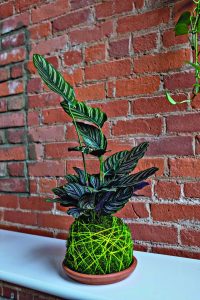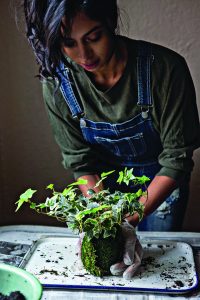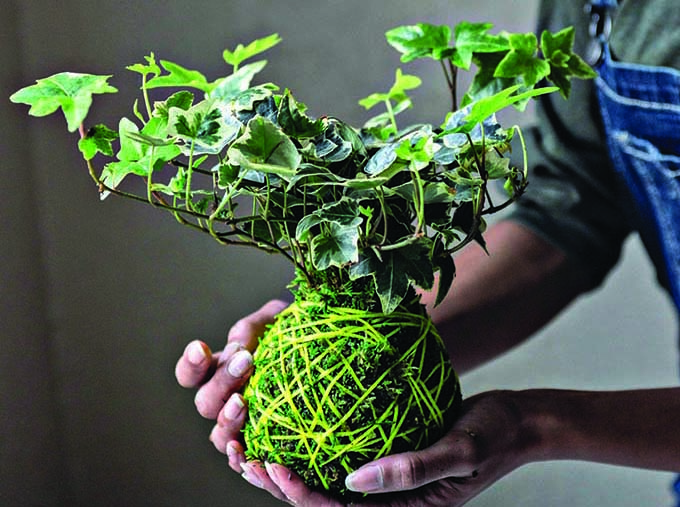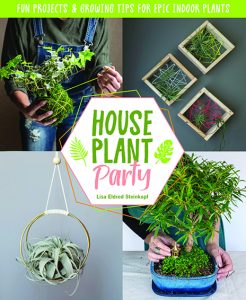Throw a Kokedama Houseplant Party
05 Apr 2021
Houseplants were all the rage in the 1970s, and then, for unknown reasons, they fell out of favor. But they’re a hot home trend once again, and offer many benefits. Here’s a fun kokedama tutorial from “Houseplant Party: Fun Projects & Growing Tips for Epic Indoor Plants” by Lisa Eldred Steinkopf.
Photos by Heather Saunders
Kokedama
String gardens have become popular on social media, but if you haven’t seen one yet, a string garden is a grouping of kokedama balls suspended from string to make a garden.
 In Japanese, kokedama means “moss ball.” It is simply a plant that has its roots wrapped in moss instead of being grown in a traditional container.
In Japanese, kokedama means “moss ball.” It is simply a plant that has its roots wrapped in moss instead of being grown in a traditional container.
Kokedama can be displayed by being hung or placed in a shallow dish. It’s an interesting and unique way to display houseplants. Any plant can be used for kokedama, but make sure the plant you want to use will grow well where you want to display it.
Because the root system is only contained in moss, it will dry out more quickly than it would in a container. You’ll have to water your kokedama more often than your plants in containers, so using a plant in high light, where the plant would require more water, may not be the best choice. If you are someone who likes to water, go for it. Otherwise, choose a medium- to low-light plant to place in a lower light level so you won’t have to water as often.
I hang a trio of these on my front porch every summer. They receive morning sun and are protected from the wind, so I only have to water them every few days. I take them down and soak them in a large pan of water until I know they have become completely moistened. They can drip on my porch, but when you water them inside, they’ll have to be left in the sink or shower until they’re done dripping.
This is a project that is fun to do with friends. Gather all the supplies, have them bring a plant of their choosing, and make an evening of it!
Materials
- Green sheet moss
- 4” to 6” (10 to 15 cm) plant
- Waxed cotton thread or colorful acrylic twine
- Potting soil or bagged topsoil
- Rubber gloves
- Newspaper or plastic sheeting
Directions
 STEP 1 Lay down newspapers or plastic to protect your work surface from mud and water. Soak your sheet moss in a bowl of water to make it easier to work with. Add water to the soil you are working with too, so that it holds together when you form the soil ball to wrap the roots with.
STEP 1 Lay down newspapers or plastic to protect your work surface from mud and water. Soak your sheet moss in a bowl of water to make it easier to work with. Add water to the soil you are working with too, so that it holds together when you form the soil ball to wrap the roots with.
STEP 2 Take your plant out of its pot and remove most of the potting medium from around the roots, being careful not to damage them or the plant.
 STEP 3 Make a firm ball of heavy potting soil (I use bagged topsoil) that doesn’t fall apart. Many kokedama sources call for something called akadama soil. This is a clay soil that holds water and helps hold the ball shape. It’s often used in bonsai soils. Akadama isn’t readily available and is a bit costly. I have been making kokedama balls for years and have never had a problem with using topsoil.
STEP 3 Make a firm ball of heavy potting soil (I use bagged topsoil) that doesn’t fall apart. Many kokedama sources call for something called akadama soil. This is a clay soil that holds water and helps hold the ball shape. It’s often used in bonsai soils. Akadama isn’t readily available and is a bit costly. I have been making kokedama balls for years and have never had a problem with using topsoil.
STEP 4 Squeeze the excess water out of the moss and lay out a circle of wet sheet moss large enough to cover the root ball. The green part of the moss will be facing down so that when the root ball is wrapped, the green side will be showing.
 STEP 5 Split the soil ball in half and add one half to each side of the root ball of your chosen plant.
STEP 5 Split the soil ball in half and add one half to each side of the root ball of your chosen plant.
STEP 6 Gently squeeze it back together, forming a sphere.
STEP 7 Set your plant in the center of the moss and bring the sheet moss up around the root ball. Make sure the entire root ball is covered, but not the stems of the plant.
 STEP 8 Wrap your thread around the middle of the ball and tie a knot to secure it. Tuck the short end in as you start wrapping the long end. Wrap the ball, turning it as you go to make sure the ball is sufficiently covered. The twine should be wrapped snugly around the ball so that it doesn’t become too loose when the ball dries out, but not tight enough to damage the plant roots.
STEP 8 Wrap your thread around the middle of the ball and tie a knot to secure it. Tuck the short end in as you start wrapping the long end. Wrap the ball, turning it as you go to make sure the ball is sufficiently covered. The twine should be wrapped snugly around the ball so that it doesn’t become too loose when the ball dries out, but not tight enough to damage the plant roots.
STEP 9 If you’d like to hang your kokedama ball, cut three or four equal-length pieces of cord. Cut the cord long enough to be able to hang your kokedama at the height you would like it. Knot each string to the wrapping cords at different spots around the ball so that it hangs evenly. Knot the strings together toward the top, and you are ready to hang your kokedama.

Kokedama Care
Check your kokedama ball often. It may dry out faster than your other plants. Make sure it is kept moist. Soak it in the sink, submerging the ball in water, and leave it there until the ball is completely moistened. Then, allow it to drain and hang it back up or return it to its bowl. Make one or make multiples to hang in a string garden in front of your window. Kokedama balls add a unique touch to your indoor garden and will mix well with your other hanging plants.
The Best Thread
Using twine or cotton thread that isn’t waxed or acrylic isn’t a good idea. Because your moss ball is wet most of the time, cotton or jute twine will rot much faster. Trust me, if your kokedama is hanging, it will end up on the floor. What a mess! Waxed or acrylic twine lasts for a long time. If you choose to display your ball in a shallow dish or on a stand, the thread choice isn’t as crucial.
Lisa Eldred Steinkopf features all things houseplants on her blog, thehouseplantguru.com. She’s the author of several books and has more than 1,000 houseplants in her home.













